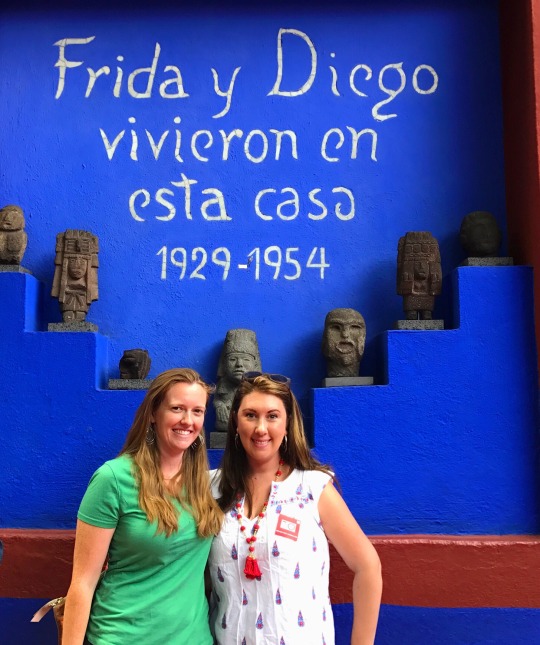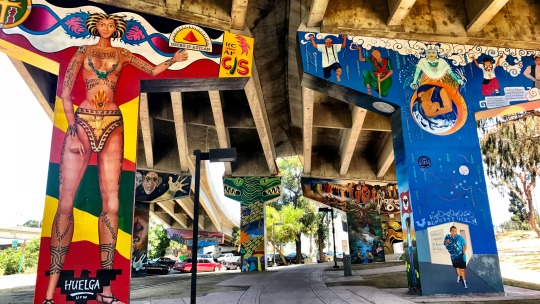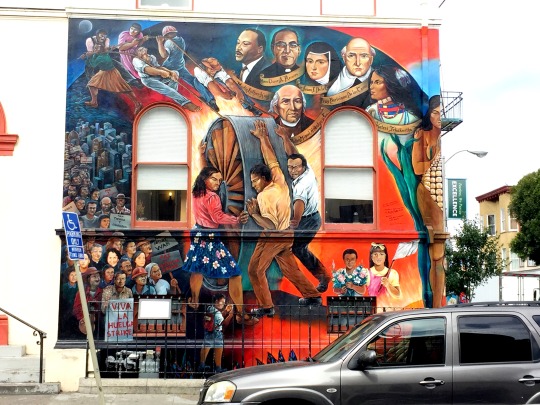On the final day of their fellowship, Alice Laramore and Kat Atkins-Pattenson shared with us their reflection on a four-week, 9,000 mile road trip along the United States/Mexico border exploring language arts, visual arts, immigration and identity. Thank you, Team Paredes Que Hablan (or Walls That Speak) for sharing your experiences and hope for future students.
Our students cross borders every day. They switch from home language to school language and back again.Their warm presence, giggles, and questions invite new families inside our school buildings. And, everywhere they go, our students carry the imprint of their family members who came to Boston for refuge, for freedom, for opportunity. Every time these young people change spaces, they reconcile their identities and pasts with their presents and futures.
 We know that for students to truly succeed academically, they must see mirrors of themselves in our curricula – art, media, and text – and validation of their identities in our classroom spaces. While we can empathize with our students, as white female teachers, we do not truly understand the depth of our students’ experiences. To effectively understand our students’ experiences, we need to cross borders ourselves and experience the displacement our students have experienced traversing these borders.
We know that for students to truly succeed academically, they must see mirrors of themselves in our curricula – art, media, and text – and validation of their identities in our classroom spaces. While we can empathize with our students, as white female teachers, we do not truly understand the depth of our students’ experiences. To effectively understand our students’ experiences, we need to cross borders ourselves and experience the displacement our students have experienced traversing these borders.
Today, the last day of our trip, we are energized by the Borders and Identity Unit that we have built and will use to launch the year with our students. We are flooded with all that we’ve seen in our seven cities. We are entrenched in the creative part of teaching, the part that involves being an interesting, engaged individual to better support the interesting, engaged individuals in our classrooms. The part that means we learn something new in order to teach something new. The experience of being a learner better prepares a teacher to teach, and this summer was an opportunity for us to authentically learn about murals on different borders, to confront not knowing and to investigate, to use art as a lens into community.
Watch in this video the artistic expression Kat and Alice captured in three countries and seven cities to help students answer the question: “How do we show other people the depth of our past and the strength of our future?”
This month, we immersed ourselves in adult project-based learning. We’ve tried lots of new things, from food to cloud-mountain hiking to driving to places we’d never been (while blogging) to talking about art from sunrise to sunset. And we’ve done the whole thing together. Often, in our classrooms, we create groups that we believe will benefit from the individuality of each member. We build in scaffolds meant to allow the group to discover each individual’s strengths and to make empathy a non-negotiable. Though we embarked with empathy and respect already in place, our twenty-six days together have illuminated the strengths and areas of growth (thanks, BPS, for the language) of our partnership. We both value efficiency, and, in the face of less-than-such (e.g., when the internet goes as turtle-pace, when people get motion sick, when you walk up the wrong side of the mountain, etc.), we have learned much about each other. That knowledge has made us better collaborators and better friends.
In San Francisco, where we started our trip, we were oriented to the idea of looking. This was not just because there was so much to look at in The Mission, but also because we did our first day with a guide, who was able to re-frame what we had seen and interpreted in the context of history and community. Carla made us cognizant of how much we needed other people’s knowledge and understanding to build our own. The Pacoima (L.A.) murals added a layer of “looking around corners” to that concept. On the hottest day of our trip, we spent the majority of it seeking out art on the walls of automotive dealerships and in the parking lots of community centers. It wasn’t always going to be all in one alley. In San Diego, a park once occupied by people and now occupied by art, had us looking for four hours and not seeing enough. We returned home those nights googling Aztec symbols and stories, trying to learn enough to know something.

Tucson and Dr. Acosta gave us yet another frame through which to experience our learning. Freedom of education does not mean freedom to learn about the American Revolution and the Civil War through a lens of whiteness. Precious Knowledge, to our generation of “urban baby teachers,” is a reflection of our intentions. Though we (the generation of “urban baby teachers”) are in no way united in our vision or our understanding of social justice, the power of conviction in ideas, history, and lifting stories and voices drove us into the work of education. We wonder if Dr. Acosta knows how many teachers who are only five or six years in are tracking his legal battle and celebrating his victories, most recently the repeal of Arizona’s ban on ethic studies which a district court deemed racist and targeting of Mexican Americans.
In Santa Fe, we absorbed the International Folk Art Market, how artists envision and reimagine, how tradition can morph modern and can accommodate the present day without reneging its roots. This mirrors the murals we’ve seen and the art of Frida Kahlo, taking symbols from the past and bringing them to life in the now. In Mexico City, we saw so much. Teotihuacan, Frida, Diego, the Anthropology Museum, street art, the culinary art of Pujol, the stained glass and craters of Toluca. With American eyes and feet, we navigated the city, and learned all that we still had to learn.
It is hard to classify this experience, and even harder to know all that it will bring to our classrooms. It falls somewhere in the vicinity of sabbatical – an intentional, purposeful break that brings new insight – but also touches the realm of professional development, continuing education, and a creative project. We envision a unit with three parts. First, with our students, we will read several memoirs that broadly address the topic of borders and walls, thinking with our students about potential barriers and how to scale them. Second, we will all generate and share memoirs from our own lives on the same topic. The author of each memoir will formulate his or her own theme about the topic, communicating a piece of knowledge gained from navigating–either adeptly or crudely–a border. Finally, after examining many primary sources collected on our trip and within Boston, students will co-construct a mural combining the themes of their memoirs to create a community creation.

The idea of “insider and outsider” has been, in many ways, the crux of our travels. We asked questions and navigated our identity as visitor, as white visitor, as American, as woman. In our classrooms we are often the the outsiders to the communities in which we teach. However our ethnicities and upbringing reflect the dominant histories and tools that are demanded from dominant culture. In this unit, we hope to illuminate these walls, supporting students to name them, scale them, and ultimately paint them. As humanities teachers, we believe that providing students vocabulary and time to think and discuss the world and its issues leads to a brighter, more creative, and smarter future than the two of us can imagine. Solutions lie in the writing, in the art, in the conversations, and in the relationships that students create. Just as we wrote in our FFT proposal, students must see themselves reflected in curriculum, in physical space, and in pedagogy in order to be successful. Because we do not physically reflect our students’ identities, we think constantly about how to make all other facets of our teaching affirming. This unit and this project will be a launching point for discussions about personal identity, community, and what comes next.
In Mexico City, the San Francisco Bay Area, Los Angeles, San Diego, Tucson and Santa Fe, this fellowship made space for us to be learners. After the twelfth grade, those opportunities almost always come with one (or many) literal costs. And Fund for Teachers (along with the school year calendar) gave us the time, space and finances to learn more in a way that will support our students, but also in a way that sustains us as teachers, professionals, and individuals. It made it possible for us to end the trip feeling rejuvenated rather than depleted. There is a constant push for teachers to continue professional development; it is indeed essential. But driving this profession development experience (and literally driving more than 900 miles) meant that we could pace our learning and reflection, and that we could intentionally choose meaningful experiences that hit our “zone of proximal development.”
If you’d like to know more about our trip, we’ve been writing the whole time. Read our blog at www.writingisthinking.org
In Solidarity,
Kat + Alice
Alice is a 7th grade Humanities/Special Education teacher at the Lilla G. Frederick Pilot Middle School in Dorchester, MA. She infuses arts into her Humanities classes, most recently taking students to do pop-up Shakespearean theater in several Boston Public libraries. She works on a cross curricular team of teachers who study the intersection of English Language Learning and Special Education to build inclusive writing experiences in all contents.
Kat is a 7th grade Humanities teacher at Gardner Pilot Academy K-8 School, a Pilot School in the Boston Public Schools. Katharine was a 2012-13 Donovan Urban Teaching Scholar at Boston College where she earned her Master’s in Secondary Education. Prior to becoming a teacher, Katharine built a college access program in rural Pennsylvania that continues to help first generation and undocumented students find the appropriate post-secondary fit while developing college and financial literacy
within the community.







 John arrived at the Globe Theatre’s “Teaching Shakespeare Through Performance” workshop as a 58-year-old literature teacher and completed his fellowship as Ophelia, Hamlet’s love interest. He explains:
John arrived at the Globe Theatre’s “Teaching Shakespeare Through Performance” workshop as a 58-year-old literature teacher and completed his fellowship as Ophelia, Hamlet’s love interest. He explains:






